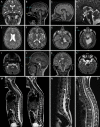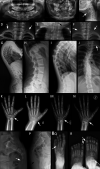Deep phenotyping of the neuroimaging and skeletal features in KBG syndrome: a study of 53 patients and review of the literature
- PMID: 37586838
- PMCID: PMC10715526
- DOI: 10.1136/jmg-2023-109141
Deep phenotyping of the neuroimaging and skeletal features in KBG syndrome: a study of 53 patients and review of the literature
Abstract
Background: KBG syndrome is caused by haploinsufficiency of ANKRD11 and is characterised by macrodontia of upper central incisors, distinctive facial features, short stature, skeletal anomalies, developmental delay, brain malformations and seizures. The central nervous system (CNS) and skeletal features remain poorly defined.
Methods: CNS and/or skeletal imaging were collected from molecularly confirmed individuals with KBG syndrome through an international network. We evaluated the original imaging and compared our results with data in the literature.
Results: We identified 53 individuals, 44 with CNS and 40 with skeletal imaging. Common CNS findings included incomplete hippocampal inversion and posterior fossa malformations; these were significantly more common than previously reported (63.4% and 65.9% vs 1.1% and 24.7%, respectively). Additional features included patulous internal auditory canal, never described before in KBG syndrome, and the recurrence of ventriculomegaly, encephalic cysts, empty sella and low-lying conus medullaris. We found no correlation between these structural anomalies and epilepsy or intellectual disability. Prevalent skeletal findings comprised abnormalities of the spine including scoliosis, coccygeal anomalies and cervical ribs. Hand X-rays revealed frequent abnormalities of carpal bone morphology and maturation, including a greater delay in ossification compared with metacarpal/phalanx bones.
Conclusion: This cohort enabled us to describe the prevalence of very heterogeneous neuroradiological and skeletal anomalies in KBG syndrome. Knowledge of the spectrum of such anomalies will aid diagnostic accuracy, improve patient care and provide a reference for future research on the effects of ANKRD11 variants in skeletal and brain development.
Keywords: Congenital, Hereditary, and Neonatal Diseases and Abnormalities; Genetic Research; Pathological Conditions, Signs and Symptoms; Patient Care; Radiology.
© Author(s) (or their employer(s)) 2023. Re-use permitted under CC BY-NC. No commercial re-use. See rights and permissions. Published by BMJ.
Conflict of interest statement
Competing interests: None declared.
Figures




References
-
- Herrmann J, Pallister PD, Tiddy W, et al. . The KBG syndrome-a syndrome of short stature, characteristic Facies, mental retardation, macrodontia and skeletal anomalies. Birth Defects Orig Artic Ser 1975;11:7–18. - PubMed
Publication types
MeSH terms
Substances
Supplementary concepts
LinkOut - more resources
Full Text Sources
